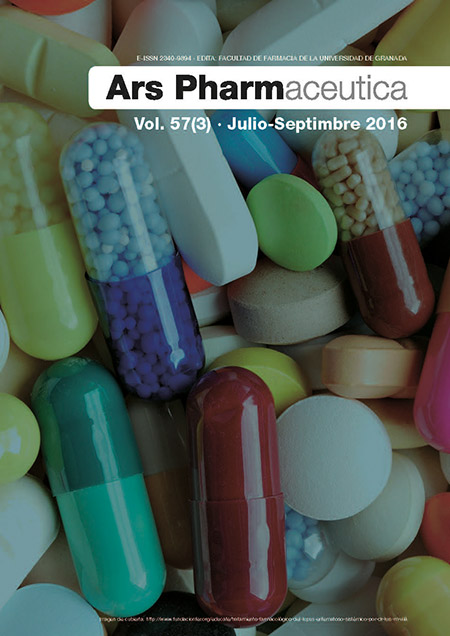Hospital effluent constitutes a source of vancomycin-resistant enterococci
DOI:
https://doi.org/10.30827/ars.v57i3.5329Keywords:
vancomycin-resistant enterococci, multi-resistance, hospital effluent, antibiotics, municipal wastewaterAbstract
Objectives: Enterococci are intrinsically resistant to many commonly used antimicrobial agents. They are able to acquire resistance with relative ease and can spread these genes to other species. Enterococci resistant to antibiotics are associated with the use of these in clinical practice and also the spread of resistant clones in the world. The aim of this work was to compare the characteristics of the strains of vancomycin-resistant enterococci (VRE) isolated from municipal wastewater and hospital effluent.
Methods: Samples were obtained from the effluent of the Hospital Universitario José de San Martín (Buenos Aires) and the municipal wastewater of the city of Buenos Aires.
Results: The bacterial counts of VRE were greater in the hospital effluent, with an odds ratio of 36.4 (95% CI: 26.0-50.8; p<0.0001). The VRE isolated were mainly identified as E. faecium. The results indicate a high prevalence of enterococci resistant to the antibiotics tested.
Conclusion: We may conclude that the effluents of hospitals constitute a source of VRE showing multiple resistance to antibiotics.
Downloads
References
Bachmann BJ, Low KB. Linkage map of Escherichia coli K12, edition 6. Microbiol Rev. 1980; 44 (1):1-56.
Baquero F, Martínez JL,Cantón R. Antibiotics and antibiotic resistance in water environments. Curr Opin in Biotechnol.2008; 19:260-265.
Beier RC, Duke SE, Ziprin RL, Harvey RB, Hume ME, Poole TL, Scott HM, Highfield LD, Alali WQ, Andrews K, Anderson RC, Nisbet DJ. Antibiotic and disinfectant susceptibility profiles of vancomycin-resistant Enterococcus faecium (VRE) isolated from community wastewater in Texas. Bull Environ Contam Toxicol.2008; 80: 188-194.
Bonten MJM, Willems R,Weinstein RA. Vancomycin-resistant enterococci: why are they here, and where do they come from? Lancet Infect Dis.2001; 1: 314-325.
Castillo-Rojas G, Mazari-Hiriart M, Ponce de Leon S, Amieva-Fernández RI, Agis-Juarez RA, Huebner J, López-Vidal Y. Comparison of Enterococcus faecium and Enterococcus faecalis strains isolated from water and clinical samples: antimicrobial susceptibility and genetic relationships. PLoS One.2013; 8(4): e59491.
Cetinkaya, Y., Falk, P. and Mayhall, C.G. Vancomycin-resistant enterococci. Clin Microbiol Rev.2000; 13: 686-707.
Clinical and Laboratory Standards Institute. Performance standards for antimicrobial susceptibility testing; 17thInformational Supplement, 2007; M100-S17.Wayne, PA, EE.UU.
Clinical and Laboratory Standards Institute. Performance standards for antimicrobial susceptibility testing; 22ndInformational Supplement, 2012; M100-S22.Wayne, PA, EE.UU.
Demerec M, Adelberg EA, Clark AJ, Hartman PE. A proposal for a uniform nomenclature in bacterial genetics.Genetics.1966; 54(1): 61-76.
European Committee on Antimicrobial Susceptibility Testing. Breakpoint tables for interpretation of MICs and zone diameters, version 5.0. 2015. [On-line]http://www.eucast.org/clinical_breakpoints/.
Farrell DJ, Morrissey I, De Rubeis D, Robbins M, Felmingham D.A UK multicenter study of the antimicrobial susceptibility of bacterial pathogens causing urinary tract infection. J Infect.2003; 46: 94-100.
Goldstein RER, Micallef SA, Gibbs SG, George A, Claye E, Sapkota A, Joseph SW, Sapkota AR. Detection of vancomycin-resistant enterococci (VRE) at four U.S. wastewater treatment plants that provide effluent for reuse. Science of the Total Environment.2014; 466-467: 404-411.
Harwood VJ, Delahoya NC, Ulrich RM, Kramer MF, Whitlock JE, Garey JR, Lim DV. Molecular confirmation of Enterococcus faecalis and E. faecium from clinical, faecal and environmental sources. Letters in Applied Microbiology.2004; 38:476-482.
Jones RN, Guzmán-Blanco M, Gales AC, Gallegos B, Leal Castro AL, Valle Martino MD, Vega S, Zurita J, Cepparulo M. Castanheira M. Susceptibility rates in Latin American nations: report from a regional resistance surveillance program (2011). Braz J Infect Dis.2013; 17: 672-681.
Kummerer K. Henninger A. Promoting resistance by the emission of antibiotics from hospitals and households into effluent. ClinMicrobiol Infect.2003; 9:1203-1214.
Leclercq R, Oberlé K, Galopin S, Cattoir V, Budzinski H, Petit F. Changes in enterococcal populations and related antibiotic resistance along a medical center-wastewater treatment plant-river continuum. Appl Environl Microbiol.2013; 79:2428-2434.
Marin ME, Mera JR, Arduino RC, Correa AP, Coque TM, Stamboulian D, Murray BE. First report of vancomycin-resistant Enterococcus faecium isolated in Argentina. Clin Infect Dis, 1998; 26: 235-236.
Martinez JL. Environmental pollution by antibiotics and by antibiotic resistance determinants. Environ Pollut.2009; 157: 2893-2902.
Novo A, Manaia CM. Factors influencing antibiotic resistance burden in municipal waste water treatment plants.ApplMicrobiolBiotechnol.2010; 87: 1157-1166.
Novick RP, Clowes RC, Cohen SN, Curtiss III R, Datta N, Falkow S. Uniform nomenclature for bacterial plasmids: a proposal. Bacteriol Rev.1976; 40: 168-189.
Paz, M., Muzio, H., Gemini, V., Magdaleno, A., Rossi, S., Korol, S. and Moretton, J. Aguas residuales de un Centro Hospitalario de Buenos Aires, Argentina: Características químicas, biológicas y toxicológicas. Hig Sanid Ambient. 2004; 4: 83-88.
Rodríguez CH, García S, Barberis C, Saposnik E, Weyland B, Nastro M, Famiglietti A. Enterococcus spp.: Resistencia antimicrobiana en infecciones intrahospitalarias. Acta Bioquím Clín Latinoam.2013; 47: 155-160.
Downloads
Published
How to Cite
Issue
Section
License
The articles, which are published in this journal, are subject to the following terms in relation to the rights of patrimonial or exploitation:
- The authors will keep their copyright and guarantee to the journal the right of first publication of their work, which will be distributed with a Creative Commons BY-NC-SA 4.0 license that allows third parties to reuse the work whenever its author, quote the original source and do not make commercial use of it.
b. The authors may adopt other non-exclusive licensing agreements for the distribution of the published version of the work (e.g., deposit it in an institutional telematic file or publish it in a monographic volume) provided that the original source of its publication is indicated.
c. Authors are allowed and advised to disseminate their work through the Internet (e.g. in institutional repositories or on their website) before and during the submission process, which can produce interesting exchanges and increase citations of the published work. (See The effect of open access).























